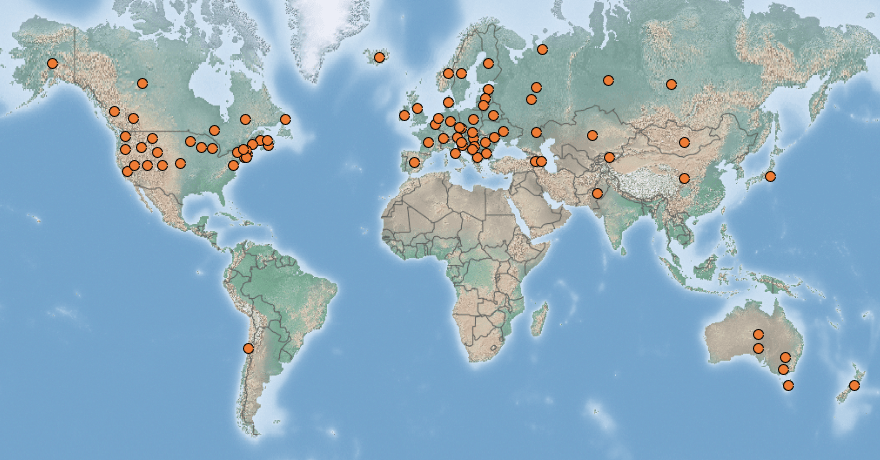 |
Garden lupin | Status LU: established. 1st record: LU <1901, ITW 1991. |
 |
Gaarde-Luppéng | Status Eur.: established. 1st record: UK 1826.1 |
 |
Lupin des jardins | RA: ISEIA: C1. Harmonia+: 0,26. |
 |
Vielblättrige Lupine | Wikipedia:     | Wikispecies: | Wikispecies:  | CABI | CABI |
 |
Vaste lupine | Back to the list of neophytes |
Contents
Report the species
→ Report Lupinus polyphyllus to the National Museum of Natural History.
Brief description
 The pioneer and ruderal plant Lupinus polyphyllus Lindl. prefers medium-moist and shaded sites, with a nutrient-poor sandy or loamy soil. It is found in riparian habitats, abandoned grasslands, forest clearings, clearcuts and on road verges. The strong invasion of semi-natural habitats, as it can be seen in Scandinavia for example, has so far been reported only rarely in western Europe. Seeds are dispersed in the immediate vicinity of the mother plant.
The pioneer and ruderal plant Lupinus polyphyllus Lindl. prefers medium-moist and shaded sites, with a nutrient-poor sandy or loamy soil. It is found in riparian habitats, abandoned grasslands, forest clearings, clearcuts and on road verges. The strong invasion of semi-natural habitats, as it can be seen in Scandinavia for example, has so far been reported only rarely in western Europe. Seeds are dispersed in the immediate vicinity of the mother plant.
L. polyphyllus may occur in extensive, rather dense stands. It reduces the diversity of early successional plant communities, but has little effect on later successional stages. In central Europe, the plant replaces species-rich dry acidic grasslands with monocultures. Due to the nitrogen-fixing nodules it may change the soil chemistry in favour of nitrogen-demanding species; eutrophication of nutrient-poor sites and consequent changes in community structure and diversity is the main problem when it invades an area (Branquart et al. 2010).
Status and distribution in Luxembourg
Records of Lupinus polyphyllus Lindl. in Luxembourg. Data source: Recorder-Lux, iNaturalist & GBIF, 2026-01-08.
Lupinus polyphyllus Lindl. was first mentioned at a meeting of the Luxembourg Naturalist Society on 1901-05-19 in Diekirch: “Mr. Klein 2 shows: (1) a specimen of Lupinus polyphyllus, a perennial plant that overwinters and, because it is very rich in nitrogen, is most suitable for green manure. […]” (Bricher 1901: 179).
The oldest herbarium specimen at the Museum was collected in June 1949 by Jos. Witry in a garden in Bergem (Specimen № 51392, MNHNL 2000-).
Lupinus polyphyllus Lindl. was first documented in the wild in Luxembourg by Yves Krippel (1992) in the forest Bambësch in Luxembourg City. The species was next documented in the wild by Guy Colling on 2002-06-15 during the Biodiversity Weekend 2002 in the municipality of Bettembourg (MNHNL 2000-).
While only few records of the species were listed in the MNHNL-mdata online portal (MNHNL, iNaturalist & GBIF 2019) a few years ago, more and more occurences of L. polyphyllus have been documented recently.
The melliferous garden lupin originates from western North America. Under the name of Lupinus polyphyllus several species, hybrids or cultivars may be confused; next to L. polyphyllus s. str., characterised by the entire upper lip of the calyx, one could observe L. perennis L., L. nootkatensis Donn ex Sims and L. ×regalis Bergm. (L. arboreus Sims × polyphyllus), recognisable by the emarginated upper lip of the calyx (Lambinon & Verloove 2012: 392).
Risk assessment
ISEIA protocol
C1 (1+2+2+2) (Ries et al. 2013: 18).
Harmonia+ protocol
Overall risk score 0,26 = (Overall Invasion score 0,55 x Overall Impact score 0,47) (Ries et al. 2020).
 Invasion
Invasion0,47

 Impact
Impact0,26

 Risk
RiskWorldwide distribution
Bibliography
- Branquart, E., S. Vanderhoeven, W. Van Landuyt, F. Van Rossum, F. Verloove & A. Vervoort, 2010. Harmonia database: Lupinus polyphyllus Lindl.. Harmonia version 1.2, Belgian Forum on Invasive Species. URL: http://ias.biodiversity.be [accessed on 2019-10-11]
- Bricher, E., 1901. Wanderversammlung in Diekirch am 19. Mai. Bulletin de la Société des Naturalistes Luxembourgeois 11 (6): 178-183.
- CABI, 2021. Lupinus polyphyllus. In: Invasive Species Compendium. Wallingford, UK: CAB International. URL: www.cabi.org/isc [accessed 2021-03-04]
- Krippel, Y., 1992. Effets à court terme d’un apport de fertilisants sur la forêt du Bambësch (Luxembourg-Ville). Travail de fin d’études d’Ingénieur agronome à l’Université Libre de Bruxelles (ULB), section interfacultaire d’agronomie, orientation agronomie générale. [mémoire non publié].
- Lambinon J. & F. Verloove, 2012. Nouvelle flore de la Belgique, du grand-duché de Luxembourg, du Nord de la France et des régions voisines. Sixième édition. Avec la collaboration de L. Delvosalle, B. Toussaint, D. Geerinck, I. Hoste, F. Van Rossum, B. Cornier, R. Schumacker, A. Vanderpoorten et H. Vannerom. Jardin botanique national de Belgique, Meise. CXXXIX + 1195 pp. ISBN : 9789072619884.
- MNHNL, 2000-. Lupinus polyphyllus Lindl. in Recorder-Lux, database on the natural heritage of the Grand Duchy of Luxembourg. Musée national d’histoire naturelle, Luxembourg. URL: https://mdata.mnhn.lu [Accessed 2019-10-11]
- MNHNL, iNaturalist & GBIF, 2019. Lupinus polyphyllus Lindl. in MNHNL-mdata, online portal combining species observation from Recorder-Lux, iNaturalist and GBIF. National Museum of Natural History, Luxembourg. URL: https://mdata.mnhn.lu [Accessed 2019-10-11]
- Ries, C. & Y. Krippel, 2021. First records of 56 invasive alien vascular plants in Luxembourg. Bulletin de la Société des naturalistes luxembourgeois 123: 115-127. [PDF 241 KB]
- Ries, C., Y. Krippel & M. Pfeiffenschneider, 2020. Risk assessment after the Harmonia+ protocol of invasive alien vascular plant species in Luxembourg. Bull. Soc. Nat. luxemb. 122: 197-205. [PDF 132 KB]
- Ries, C., Y. Krippel, M. Pfeiffenschneider & S. Schneider, 2013. Environmental impact assessment and black, watch and alert list classification after the ISEIA Protocol of non-native vascular plant species in Luxembourg. Bull. Soc. Nat. luxemb. 114: 15-21. [PDF 652 KB]
Suggested citation of this webpage
Ries, C., M. Pfeiffenschneider & Y. Krippel (Eds.), 2026. Lupinus polyphyllus Lindl. In: neobiota.lu - Invasive Alien Species in Luxembourg. National Museum of Natural History, Luxembourg. URL: https://neobiota.lu/lupinus-polyphyllus/ [Accessed 2026-01-08].
Page content last updated on 2022-06-14. Last proofread by Caroline Grounds on 2019-11-19.


